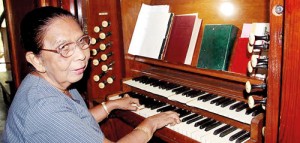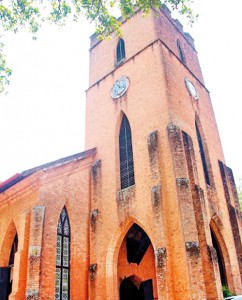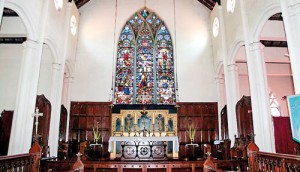From Bradford UK, to St. Paul’s Kandy
View(s):Namali Premawardhana uncovers the tale of a pipe organ whose glorious sounds
have been heard since 2009 at a World Heritage site in bustling Kandy town
As Christians around the globe celebrate the resurrection of Jesus Christ this Easter morning, nestled in the heart of Kandy, a faithful servant of the church waits for its own reawakening.
The pipe organ currently at St. Paul’s Church, Kandy, began its life at a Presbyterian church in Frizinghall on the edge of Bradford, UK. Once a very prosperous suburb of the city, home to the Bradford Grammar School, the first church-home of this organ is still surrounded by large fine houses. In the last 50 years though, the demography of the region has changed from a largely Christian to a largely Muslim population, resulting in the closing down of many of its smaller churches. The church to which the instrument belonged was closed in 2009 and the building sold to a property developer for conversion to a supermarket. As this deal came to a close, the organ was advertised online.

Organist Dilanganie Bhareti: Playing faithfully Sunday after Sunday
At the same time, Rev. Canon David Whittington, on a mission repairing pipe organs in Sri Lanka, was on the lookout for an instrument for St. Paul’s Church in Kandy. The original instrument, a fully pneumatic system more than a century old, was no longer in a condition worth repairing or maintaining. There being no real market for second-hand organs, Rev. Whittington was able to buy the new semi-pneumatic, direct-injection instrument for a mere 500 pounds. Paul Bell, Rev. Whittington’s partner in musical revival, and Trevor and Diane Turner, their friends and supporters, volunteered to help dismantle and reinstall the organ for St. Paul’s, further reducing the cost of the instrument. A sponsor was also found who would pay the shipping from the UK to Sri Lanka. At the end of this chain of generosity, St. Paul’s Church in Kandy bore a total cost of Rs. 53,000 as customs fees for the purchase and installation of their new pipe organ. For the grand figure the instrument now cuts on the West loft of the church, this is hardly a price to have paid.
Between the purchase of the new instrument and its arrival in Sri Lanka, St. Paul’s Church was also busy preparing for it.

Awaiting a facelift: St. Paul’s Church, Kandy. Pix by Ashwin Dominique Jayalath
“The old instrument was spread across this whole space,” Keerthi Bhareti, a former Trustee of St. Paul’s Church who spearheaded the project of replacing the old organ with the new, explains, gesturing across the choir loft. But the new instrument was to be encased in a smaller area in the centre of the loft, meaning that portion of the structure needed strengthening. With the advice of a structural engineer, two reinforced concrete pillars, two horizontal H-iron girders and three cross-girders were added to the existing loft support, to prepare it for bearing the four-tonnes of pipes, levers, valves and blowers that make up this magnificent sound-machine.
The burnished brown wooden casing which covers the pipes numbering over one thousand is around 15 feet tall, long and wide. Inside the casing, row upon row of wooden and metal pipes, some over eight feet high, some miniscule in comparison, connect with the keyboards (only three or four feet wide) via a series of levers. The keys, when pressed, channel air from the massive blower to the heaving wooden platform, through the corresponding pipes, and out of the valves, creating a variety of auditory experiences, based on which stops on the keyboard panel are pulled out or pressed in. The result is the glorious rising of the ringing, rounded tone of the pipes, swelling to a sweet and smooth crescendo, lifting the worshippers’ spirits up with the music.
August 27, 2009.
“It was three o’clock in the morning when it arrived at the church,” Dilanganie Bhareti, organist at St. Paul’s church reminisces excitedly.
The instrument arrived at its new home in a forty-foot container.
“It took Paul Bell and the others a number of hours just to unload everything,” says Mr. Bhareti, “just to unload it!”
Sunday, November 1, 2009, there was a special ceremony at the beginning of the usual service at St. Paul’s Church, Kandy. The old organ was heard for the last time beneath the fingers of Assistant Organist Deekshya Illangasinghe playing ‘Londonderry Air’ and Dilanganie Bhareti on the ‘Water Music’ suite.

Interior of St. Paul’s: The magnificient stained glass window is located behind the altar
This instrument had been gifted to the church in the 1880s, in memory of Lawrence St. George Carey, who was a planter at Le Vallon Estate in Pussellawa. Over the years, Harry Gunetilleke and Noel Janzel served the congregation of St. Paul’s church at its keyboard. Janzel had a reputation for being unable to tolerate anything less than perfect, and played until he was nearly 90 years old.
Mr. Bhareti remembers that “a few years” after March 1993, when it was played at the 150th anniversary of the church, “the organ went out of service”. In the following 12 years, Rev. Fr. Mark Berrard, a French Roman Catholic clergyman living in retirement in Colombo made multiple efforts to restore the instrument, during which period the congregation was accompanied at service by a small Yamaha keyboard. In 2005, the lower “great” keyboard was restored to reasonable working order, and accompaniment on the instrument resumed. Sadly though, the sudden demise of Rev. Berrard meant that the instrument was not maintained in good condition, though it was being played regularly, over the next few years. By the time Rev. Whittington was invited in 2008 to hear the instrument and test its condition, it proved itself too costly to repair and maintain.
After an address by senior chorister Walter Perera and a prayer of thanksgiving by the vicar, the congregation bid a poignant farewell to the instrument which had served them faithfully, to the best of its ability, for over a century.
Dilanganie Bhareti, member of St. Paul’s church since 1970 has been organist for the last ten years, since the original instrument was repaired by Rev. Berrard.
“I’m not an organist,” she smiles, “just a humble piano teacher.”
But faithfully, week after week, year after year, she sits at the keyboard, doing what is required of her. Assistant Organists Deekshya Illangasinghe and Shalindri Mendis-Joachim help her as often as possible.
“I’m old now, you know,” Mrs. Bhareti says, “I don’t know how much longer I can keep doing this.”
A mischievous demeanour and easy laughter indicate that her heart is far younger than her years, but the organist has trouble climbing up the stairs to the loft where she must sit.Who will take after her? No one really knows. At 75, she is constantly canvassing to get the choristers more involved, and more organists trained, but despite her efforts, nothing sustainable has yet presented itself.
The organ at St. Paul’s Church in Kandy is one of only six pipe organs in the country.
“Some organs tend to be too in your ear, but this has a good tone and lots of potential,” said Denham Pereira, Director of Music and Organist at St. Andrew’s Scots Kirk, who performed on the instrument in August of 2014. As he pointed out though, maintenance of the instrument is an issue.
“These instruments are designed for the cool climatic conditions of the UK,” says Hamindra Fernando who visits St. Paul’s Church in Kandy regularly to maintain the upkeep of its pipe organ.
The damp and dust of our tropical climate inevitably create trouble for the instrument, as he points out. “There is no lifespan for these instruments; they are made to last up to a thousand years.”
The only requirement is regular care.
Fernando learnt his work from Rev. Whittington five years ago, and has been heavily involved in the installation and upkeep of instruments at Holy Emmanuel church in Moratuwa and the church of St. Francis of Assisi in Mount Lavinia as well as others, since.
The clock on St. Paul’s tower has a similar tale to that of its organ. Donated by the same benefactor, and installed in1885, it sits in the dark of the high machine room beneath the belfry, steadily ticking away the decades. Ruwan Seneviratne learnt the mechanism of the clock from his father, a technician for Francis Perera who maintained it until the 1990s. Seneviratne comes in every five days to wind the mechanism by the light of a single bulb, and make sure everything is in good working condition.
“It takes over half an hour just to wind it,” Mr. Bhareti explains, “and at the end of it he comes down pouring with sweat.”
Those like the Bharetis who have worshipped at St. Paul’s Church over the years and remember her former magnificence are looking forward the Cultural Triangle facilitating a complete facelift for the church, hopefully turning it from being simply maintained to being admired. St. Paul’s Church, Kandy, is a World Heritage Site, its pipe organ, clock tower, intricately patterned mosaic tiles and decaying artwork in the galleries holding century-old secrets and tales, and a fragile and serene beauty that can no longer be replicated. In the heart of a city with so much rich history that it is drastically undervalued, she awaits patiently, her return to glory.


